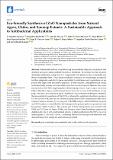| dc.contributor.author | Channa, G. Mustafa | |
| dc.contributor.author | Iturbe-Ek, Jackeline | |
| dc.contributor.author | Sustaita, Alan O. | |
| dc.contributor.author | Melo-Maximo, Dulce V. | |
| dc.contributor.author | Bhatti, Atiya | |
| dc.contributor.author | Esparza-Sanchez, Juan | |
| dc.contributor.author | Navarro-Lopez, Diego E. | |
| dc.contributor.author | Lopez-Mena, Edgar R. | |
| dc.contributor.author | Sanchez-Lopez, Angelica Lizeth | |
| dc.contributor.author | Lozano, Luis Marcelo | |
| dc.date.accessioned | 2025-06-10T17:55:11Z | |
| dc.date.available | 2025-06-10T17:55:11Z | |
| dc.date.issued | 2025-05-16 | |
| dc.identifier.uri | https://hdl.handle.net/1721.1/159385 | |
| dc.description.abstract | Traditional methods of synthesizing nanoparticles often rely on physical and chemical processes using synthetic hazardous chemicals. In contrast, the rise in green chemistry emphasizes using bioactive compounds from plants for the eco-friendly synthesis of nanostructures. These green synthesis techniques are increasingly recognized for their simplicity, cost-effectiveness, and ability to yield non-toxic by-products, an approach that aligns with sustainable practices. In this research, a straightforward, cheap, environmentally friendly, and sustainable procedure was developed to fabricate Zinc oxide nanoparticles (ZnO-NPs) employing three different pulp extracts: Agave (Agave americana), Chiku (Manilkara zapota), and Soursop (Annona muricata) to serve in the synthesis as capping, reduction, or stabilization agent. Analytical characterization techniques confirmed the successful phytosynthesis of ZnO-NPs, evidenced by significant absorbance peaks of UV-Vis spectra at 362 nm, and the chemical composition of ZnO without noticeable traces of phytochemical residues by carrying out ATR-FTIR analysis. SEM, STEM microscopies, and XRD analysis verified that the ZnO nanoparticles possess spherical geometries and hexagonal crystal structures. The average size of these nanoparticles was around 15.94, 18.08, and 23.32 nm for Agave, Chiku, and Soursop extract-based synthesis, respectively. Additionally, the in vitro antibacterial activity of phytosynthetized ZnO-NPs was evaluated against E. coli and S. aureus, confirming effective bacterial growth inhibition and demonstrating their significant antimicrobial potential. | en_US |
| dc.publisher | Multidisciplinary Digital Publishing Institute | en_US |
| dc.relation.isversionof | http://dx.doi.org/10.3390/cryst15050470 | en_US |
| dc.rights | Creative Commons Attribution | en_US |
| dc.rights.uri | https://creativecommons.org/licenses/by/4.0/ | en_US |
| dc.source | Multidisciplinary Digital Publishing Institute | en_US |
| dc.title | Eco-Friendly Synthesis of ZnO Nanoparticles from Natural Agave, Chiku, and Soursop Extracts: A Sustainable Approach to Antibacterial Applications | en_US |
| dc.type | Article | en_US |
| dc.identifier.citation | Channa, G.M.; Iturbe-Ek, J.; Sustaita, A.O.; Melo-Maximo, D.V.; Bhatti, A.; Esparza-Sanchez, J.; Navarro-Lopez, D.E.; Lopez-Mena, E.R.; Sanchez-Lopez, A.L.; Lozano, L.M. Eco-Friendly Synthesis of ZnO Nanoparticles from Natural Agave, Chiku, and Soursop Extracts: A Sustainable Approach to Antibacterial Applications. Crystals 2025, 15, 470. | en_US |
| dc.contributor.department | Massachusetts Institute of Technology. Department of Mechanical Engineering | en_US |
| dc.relation.journal | Crystals | en_US |
| dc.identifier.mitlicense | PUBLISHER_CC | |
| dc.eprint.version | Final published version | en_US |
| dc.type.uri | http://purl.org/eprint/type/JournalArticle | en_US |
| eprint.status | http://purl.org/eprint/status/PeerReviewed | en_US |
| dc.date.updated | 2025-05-27T12:54:17Z | |
| dspace.date.submission | 2025-05-27T12:54:17Z | |
| mit.journal.volume | 15 | en_US |
| mit.journal.issue | 5 | en_US |
| mit.license | PUBLISHER_CC | |
| mit.metadata.status | Authority Work and Publication Information Needed | en_US |
